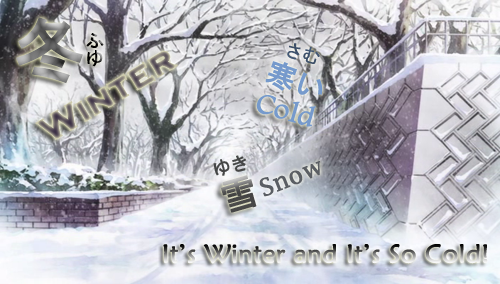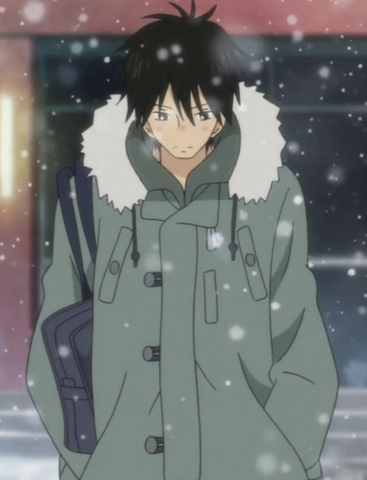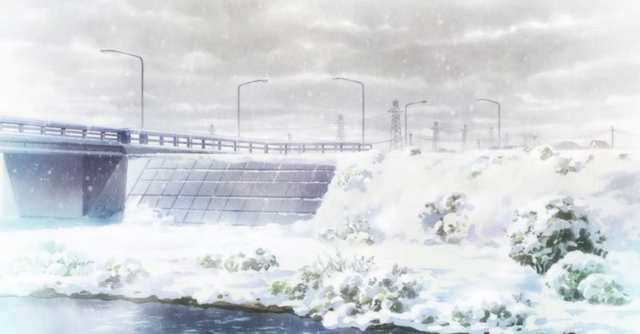The
seasons result from the Earth's axis being tilted to its orbital plane; it deviates by an angle of approximately 23.5 degrees. Thus, at any given time
during summer or winter, one part of the planet is more directly exposed to the
rays of the Sun (see Fig.
1). This exposure alternates as the Earth revolves in its orbit. Therefore,
at any given time, regardless of season, the northern and southern
hemispheres experience opposite
seasons.
The
effect of axis tilt is observable from the change in day length, and altitude of the Sun at noon (the culmination of the Sun), during a year… so-
STOP  !
STOP
!
STOP  , STOP
, STOP  , STOP
, STOP  !
!
 !
STOP
!
STOP  , STOP
, STOP  , STOP
, STOP  !
!
Oh,
sorry (for going off-topic  …)…
…)…
 …)…
…)…
*Kaoko made a tea
and sat beside the window*
Kaoko: あぁ、 世界を見ながらお茶を飲むとさいこうだわ! (Ā〜 sekai wo minagara ocha wo nomu to saikou da wa.) - Ah~ Drinking tea while
viewing the world is the best  .
.
 .
.
Akemi: 何言ってるの。雨が降ってるよ。窓を閉じなさい、まったくよ。雰囲気が暗い感じになるぞ。(Nani itteru no? Ame ga futteru yo. U~indou wo tojinasai, mattakau
yo... fun'iki ga kurai kanji ni naru zo.) What are you talking about?
It’s raining. Close the window, geez… it makes the atmosphere feels gloomy  .
.
 .
.
Kaoko: あたしは雨と冬が大好きだ。 (Atashi wa ame to fuyu ga daisuki da.) - I love the rain and
the winter  .
.
 .
.
Akemi: 何で (Nande?) - Why?
Kaoko: 冬は、本当に寒いでしょ。朝は、起きるのが嫌になっちゃうでしょ、毛布にくるまってるとすごく気持ちがいいでしょ。起こされたら、リビングのこたつにこっそり入って、気持ちのいい間にもう一回寝るでしょ。冬はね、何もしたくなるものよ。 (Fuyu wa, hontou ni
samui deshou. Asa wa, okiru no ga iya ni nacchau deshou, moufu ni kuru
matteru to sugoku kimochi ga ii deshou. Okosaretara, ribingu no kotatsu ni
kossoru haitte, kimochi no ii aida ni mou ikkai. Fuyu wa ne, nani mo
shitakunaru mono yo.) - In
winter… it’s just so cold. In
the mornings, you don’t feel like getting up and it’s so comfortable to sleep
inside the blanket. If forced to wake up, you get to sneak in the kotatsu in the living room and sleep
again while feeling so comfortable. In winter, you just don’t feel like doing
anything.
Akemi: 怠け者なだけだ。(Namekemonona dake da.) - You are just lazy.
So
first we’ll be learning about is… winter!
It’s
Winter and It’s So Cold!
Kaoko: 冬に時は一杯雪があるよ。 (Fuyu ni toki wa ippai yuki ga aru yo.) – When winter comes,
there’ll be a lot of snow.)
Hizashi: 君は雪とか、冬とか、寒いものが好きですね。 (Kimi
wa yuki toka, fuyu toka, samui mono ga suki desu ne.) – You really like
cold things, such as snow and winter, don’t you?
Kaoko: 勿論よ。楽しいから。(Mochiron yo. Tanoshii kara.) – Of course. Cause they are fun.
Hizashi: 然し、あなたは冬時には何もしない。 ただ、ぶらぶらするだけです。 (Shikashi, anata wa fuyu toki ni wa nani mo shinai ja. Tada,
burabura suru dake desu.) However, you do nothing but laze around during
winter.
Kaoko: …
What You Wear During Winter:
In
winter, you wear warm clothes, in other words you put on a lot of clothes
(…well, not necessary….)!
Anyway,
let’s list in things (in Japanese with the English translation) you wear during
the winter season:
·
沓下/くつした (kutsushita - socks; sock; stockings; stocking)
·
ジャンパー (jampaa
- jumper)
·
切れの帽子/きれのぼうし (kire
no boushi - cloth hat)
·
ニットキャップ (nitto kyappu - knit cap; woollen hat)
·
手袋/てぶくろ(tebukuro - glove; mitten; mitt)
·
スエーター (suwiitaa
- sweater)
·
長靴/ちょうか (chouka-> fairly high shoes; boots)
Fun
Example 1:
Hizashi: カオコちゃん、僕の青い靴下わは何処にあるとか知てますか? (Kaoko! Boku no aoi kutsushita wa doko ni aru
to ka shitemasu ka?) – Kaoko! Do you know where my socks are?
Kaoko: あ、知ってるけどさ。何で? (Ah, shitteru kedo sa. Nande?)
– Ah, I know where it is, but why do you ask?
Hizashi: いいから、教えて下さいよ! (Ii kara, oshiete kudasai yo!) – Never mind that, just tell me where
it is!
Kaoko: 言わないと教えて上げない。 (Iwanai to oshiete agenai.) – I you don’t tell me I won’t tell you
where it is.
Hizashi: まったく、寒いから足が冷たいになってんです。その青い靴下は僕のお気に入りなんです。 (Mattaku, samui kara ashi ga tsumetaku natten
desu. Sono aoi kutsushita wa boku no okiiniri nan desu.) – Oh geez. Because
it’s really cold, my feet are freezing. And those blue socks are my favorite.
Kaoko: あ、そうか。 (Ah,
sou ka.) – Oh, I see.
Hizashi: じゃ、どこ? (Ja, doko?) – So, where is it?
Kaoko: その大事な靴下なら、私が履いています。(Sono daijina kutsushita nara, watashi ga haiteimasu.) - About that
important socks… I’m wearing it right now.
Hizashi: 何! (Nani!) – What!?
Fun
Example 2:
Mother: ちょっと、カオコ。あんた何処に行くの? (Chotto! Kaoko, anta doko ni iku no?) – Wait, Kaoko! Where are you
going?
Kaoko: あけみちゃんの家に。 (Akemi-chan no ie ni.) – To Akemi-chan’s house.
Mother: これで? (Kore de?) – Like that?
Kaoko: 何。 (Nani?) –
What?
Mother: 外が寒いのよ。そんなんで外に出たら、風邪をひくわよ。 (Soto ga samui no yo. Sonnande
soto ni detara, kaze wo hiku wa yo.) – It’s really cold outside. If you go
out like that, you will catch a cold.
*Mother fetches some clothing from Kaoko’s room*
Mother: はい、これ。この靴下を佩きなさい。 (Hai, kore. Kono Kutsu shita wo hakinasai.) Here. Wear these
socks.
*Kaoko wears the socks her mother gave her*
Mother: あんた、いったい何考えてんの、そのサンダルを掃いて。 (Anta, ittai nani kangaete nno. Sono sandaru wo haite.) – What on
earth were you thinking? Wearing those sandals…
*Mother takes
boots from the shoe shelf and gives it to Kaoko*
Mother: ほら、サンダルを 脱いで
その代わりにこの長靴を履いて。(Hora, sandaru wo nuide, sono kawarini kono
chouka wo haite.) – Now, take off those sandals and wear these boots
instead.
*Kaoko takes off her sandals and wears the boots*
Mother: ほら、スカーフも。 (Hora, suka~fu mo) – Here, wear a scarf, too.
*Kaoko put on the scarf around her neck*
Mother: 上着。 (Uwagi.) –
Jacket.
*Kaoko wears the Jacket*
Mother: それから、手袋。(Sorekara,
tebukuro.) – And finally; cotton gloves.
Kaoko: 心配すぎじゃない、お母さん。(Shinpai sugi ja nai, okaa-san.) - Aren’t you worrying too much,
mother?
Mother: 風ひっちゃったら、お母さんも困るでしょう。 (Kaze hitchattara, okaa-san mo komaru deshou.)
- If you catch a cold, won’t I be troubled?
Kaoko: 色々有難う。じゃ、行って来ます。 (Iroiro arigatou na. Ja, ittekimasu.) – Thanks for everything. OK, I’m
off then.
Mother: 行ってらっしゃい。(Itterasshai.) – Take care.
Note:
|
To wear/to put on in
English somehow differs from it translation in Japanese.
In English, if you say ‘wear’,
it can be for: socks, shirts, trousers, gloves, jackets, etc. But when you
translate it in Japanese, you won’t always get the same word. Take a look:
·
For the upper body clothing (for example: shirts, dresses, vest, etc.) you use着る (kiru).
·
For the lower body clothing (for example: skirt, socks, trousers, etc.) you use佩く (haku).
|
And now for the final of the winter lesson… have you
ever read/seen/heard of a Kotatsu?
火燵 - Kotatsu
A kotatsu
(炬燵) is a low, wooden
table frame covered by a futon, or
heavy blanket, upon which a table top sits. Underneath is a heat source, often
built into the table itself. Kotatsu
are used almost exclusively in Japan, although similar devices are used
elsewhere.
A kotatsu
is a relatively inexpensive way to stay warm in the winter, as the futons trap the warm air. This is also the time of
the year where many activities take place around the kotatsu, such as eating, reading, watching television, and
socializing. Families may choose to concentrate their activity to this one area
of the house in order to save on energy costs. In the summer, the blanket may
be removed, and the kotatsu can be
used as a normal table. Read
More!
火燵はさいこうです! (Kotatsu wa saikou desu!) – Kotatsu is
the best!
Author’s Note:
OK! Now that was one a tiring piece of work. Thanks to xpon who came up with a
suggestion, and HildeChan and t a e from Lang-8
who corrected my mini stories. The lesson for winter is now completed. I haven’t
written the lesson parts for spring, summer, and autumn yet (and also the
weathers). But I’ll be working on it as soon as possible! Look forward for the
next lesson… the spring!
(P.S. I’ll only be
updating this post by adding the spring lesson)







.png/640px-Kotatsu_(gintama).png)
No comments:
Post a Comment